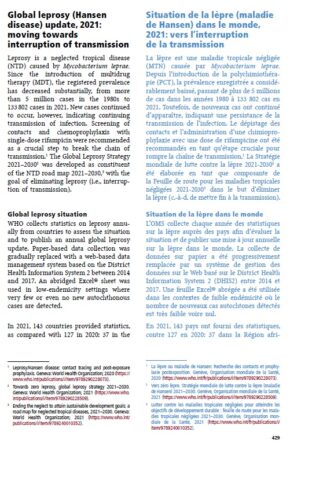
Global Leprosy Update 2021
The WHO Global Leprosy Programme has published the Global Leprosy Update for 2021 in the Weekly Epidemiological Review and the Global Health Observatory. The reported data shows further progress in spite of the COVID pandemic, whose dampening effects on routine control activities are clearly demonstrated. It is encouraging to see that the number of countries reporting data has increased again (160 in 2019; 127 in 2020 and 143 countries in 2021) and as the DHIS2 reporting platform is more widely used, we may expect that the quality of the data is also improving each year.
The WHO report presents the current situation in detail, through comprehensive Tables and Figures, with additional information in the text about leprosy reactions, relapses, adverse drug reactions and antimicrobial resistance. There is commentary on the effects of COVID-19 and on progress towards interrupting transmission.
The Editorial notes with concern the number of children diagnosed with Grade 2 disability (G2D), and this can be studied in more detail. By region, the number of children with G2D at diagnosis during 2021 is as follows:
| AFR | 262 |
| AMR | 31 |
| EMR | 2 |
| EUR | – |
| SEAR | 62 |
| WPR | 11 |
| Total | 368 |
It is noteworthy that of all children reported with G2D, over 70% were diagnosed in Africa. Looking at the individual country data, there are 7 countries in Africa with 10 or more such cases (Angola, DRC, Ethiopia, Mozambique, Senegal, South Sudan and Uganda). It is important to realise, however, that we do not know the actual total number of new child cases with G2D. India only reported 41 (out of 4107 new child cases) and Indonesia (16 out of 1133), while Brazil reported 29 out of 761 child cases. It is likely, therefore, that the total number of child cases with G2D is considerably higher than that 368 reported in 2021.
Another surprise is that, as shown in Table 1 and Figure 3, AFR has overtaken SEAR for the first time, as the region with the highest number with G2D amongst all new cases. Last year’s Update for the year 2020 showed regional trends over ten years in the numbers of new cases with G2D (Table 2), with a steeply declining trend in SEAR and a slowly increasing trend in AFR. Table 4 in the current paper shows that Mozambique had a very marked increase in G2D numbers in 2021, although this may be mainly a reflection of the 41% increase in the total number of new cases reported in Mozambique since 2019 (2019: 2220; 2020: 2065; 2021: 3135). Such fluctuations may relate to changes in service provision during the pandemic, but may also be linked to better data collection and reporting.
These data should serve as a reminder that intensified efforts are needed in many countries in Africa. It may be that the data point to more activities and better reporting, but it is well-known that issues of infrastructure and capacity-building need much more investment across the continent if we are to reach the targets we have set.
Overall, it is good to note that childhood leprosy is declining globally quite steeply, as shown in Table 2, and that G2D at a global level is also declining gradually to the target of < 1 case per million (Table 1). Table 1 also points out, however, that Africa is well behind other regions in this regard.
Thirty-seven countries reported zero new autochthonous cases of leprosy, while 67 reported zero child cases. This indicates that many countries are well on the way to achieving the new milestones of interruption of transmission and elimination of leprosy disease. In fact, 14 countries have already reported zero new child cases for 5 consecutive years and have therefore met the new milestone for interruption of transmission.
With thanks to Dr Paul Saunderson, ILEP Technical Commission, for this commentary.